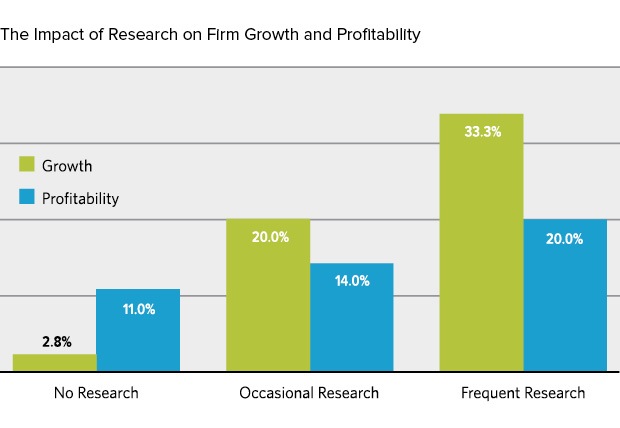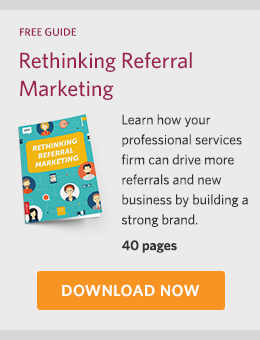Assessing the current state of your firms referral marketing strategy is in large part about understanding your audiences.
In order to encourage referrals — and ultimately to generate new business — it’s essential that you understand your target audience of buyers and influencers. What is important to them? What are their challenges and interests? Without the answers to these questions, you’re moving ahead with some serious blind spots. But when you have this knowledge, you can gain a decisive advantage over the competition.
Eliminating Your Blind Spots
Time and again, we’ve seen that the key to getting past your strategic blind spots is research. In fact, it’s our own professional services marketplace research that has brought that lesson home so clearly for us. In a comparative study on professional services providers’ research habits, we found that research made a powerful impact on firms’ bottom lines.

The takeaway? Firms that conduct systematic research on their current and potential clients grow three to ten times faster — and are up to two times more profitable.
What makes research so influential? How does it make such an impact? The fact is that if you’re not conducting regular research, you probably don’t know clients and prospects as well as you think you do. That’s not a reflection of your insight, but rather the tendency for blind spots, myths, prejudices, and assumptions to guide our thinking in the absence of empirical data.
Many decision-makers might respond to this line of argument by saying, “I work closely with my clients every day. I know more about my marketplace than research could ever tell me.”
This is a mistake. Your current clients may not be representative of the market — and even if they are, the market will evolve. Regular research helps you track shifts in the marketplace and act based on what’s happening right now. Market research can illuminate which services you should offer and how and when to offer them.
If there is an underserved niche, a need that’s not being met, or some other form of blind spot, you’ll find it. And you’ll be prepared to move ahead with clarity. With this kind of targeted focus, you will be able to much more effectively speak to the concerns of your target audience — and consequently encourage referrals based on your expertise and reputation.
SEE ALSO: Rethinking Referral Marketing: Where Are You Now?
What Are Your Audience’s Challenges and Priorities?
In order to speak to your audience’s problems and needs, you need to understand them. The best way to understand them is through primary research, surveying and studying your audience directly. Online surveys are a great way to collect this data.
 If you don’t have the time and resources to conduct primary research, you might consider secondary research. In this approach, you can analyze other parties’ findings and make conclusions that will help guide your business. Independent industry organizations are often a good source for such data, though the disadvantages of secondary research are that you can’t control the parameters, currency, or quality of the data you use.
If you don’t have the time and resources to conduct primary research, you might consider secondary research. In this approach, you can analyze other parties’ findings and make conclusions that will help guide your business. Independent industry organizations are often a good source for such data, though the disadvantages of secondary research are that you can’t control the parameters, currency, or quality of the data you use.
Of course, you sometimes may need help figuring out the right questions to ask to find out what you need to know. What kinds of challenges and priorities should you be asking your survey respondents about in the first place? Here, it’s helpful to do some good old-fashioned digging. Top areas to look for clues include:
1. Your own online content.
If you’re already publishing educational content, this can be a strong indicator. Identify high-performing content to find which pieces have generated the most traffic or have been shared most frequently on social media. Are there are common threads in the subject matter? This can indicate an area of particular interest for your audience.
2. Your network.
Consult your sales, business development, and account teams to learn what questions and objections they encounter regularly. Are there any commonalties or surprises here? These may be areas to follow up on. You can also start a conversation on social media, asking your contacts and followers what they view as top challenges and priorities in their industry. The answers may be revealing.
3. Online and in social media.
Speaking of social media, it can be a great place to gather data without asking questions outright. What topics are trending in your industry? What issues are in the news, and what problems are people talking about?
Better yet, where does your target audience go for advice and insight? Where do they network? You can gain crucial information by looking up leaders among your target audience, finding which LinkedIn Groups they belong to, and following relevant conversations.
Another great source of information is competitors’ websites. Are they talking about issues that you are not?
With the information you gather from these disparate sources, you should develop the raw material for some powerful questions and avenues of investigation. And by using research to understand your audience, you’ll have the basis for a focused and efficient referral marketing strategy, connecting more reliably with your audience and leading ultimately to new business.
Additional Resources:
- Get a step-by-step guide to building a powerful referral strategy with our free Rethinking Referral Marketing Guide.
- Dig into the research behind generating referrals today with our free Referral Marketing for Professional Services Firms research report.
How Hinge Can Help:
Interested in generating more referrals? That’s what Hinge helps professional services firms do. Contact us to learn how we can help you increase marketplace visibility, generate more referrals, and grow faster.


